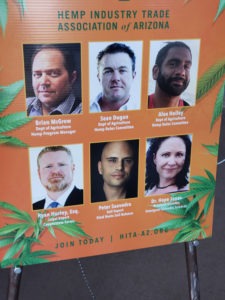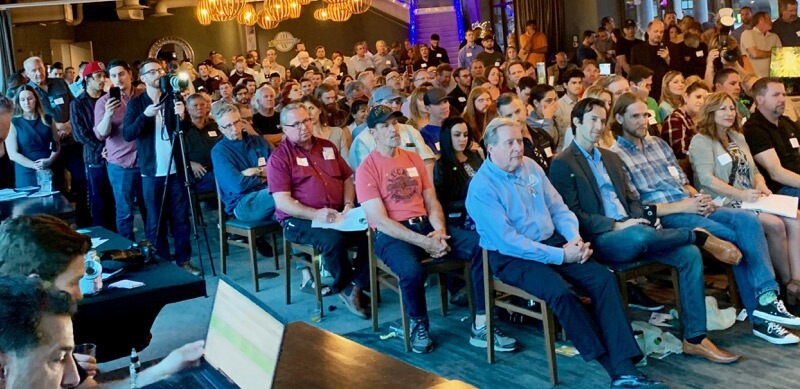BY ACM STAFF
Hundreds of soon-to-be hemp entrepreneurs packed themselves into Scottsdale’s OdySea View restaurant to witness the launch of HITA, AZ’s new Hemp Industry Trade Association Thursday, April 11. “In a way, you are all pioneers!” proclaimed HITA President “Sully” Sullivan in his opening remarks.
The networking event served as the catered kick-off for Sullivan’s newly-developed HITA organization. It comes just in time for growers and processors to set their own plans into motion ahead of the June 1 start date for the AZ Dept. of Agriculture’s Industrial Hemp program. “Thank you for joining what may be the largest agricultural movement in America in the last 100 yrs!” Sullivan said, and he should know.
Unleashing a Giant
Two years ago sullivan, in addition to founding HITA along with design savant Laura Franklin, Sully founded Tangent West, a hemp consulting firm, and the Arizona Hemp Supply Co. A vertically-integrated hemp cultivation, processing, and distribution company AHSC’s reach covers Arizona, Colorado, California, and Oregon.
“Arizona is uniquely poised to become a leader in the field. With your help, there’s no reason Arizona cannot become America’s leader in hemp production!” Sully shouted to the cheering crowd. After a brief introduction, he let the crowd shape the discussion and entertained more than an hour and a half of questions for his all-star panel of hemp experts.
The Hemp Dream Team

AZDA Industrial Hemp Program Manager Brian McGrew was on hand to update the literally overflowing crowd on the latest developments in shaping the program that McGrew and others hope will make AZ a national leader in US hemp production. McGrew’s committee of AZ’s farming and hemp experts spent much of the last year getting ready for the June 1 launch.
The panel included McGrew’s hemp program committee members, Sean Dugan and Alex Holley, who proved as feisty and entertaining as ever. Holley even worked an F-word into his opening remarks in honor of the coverage his colorful language in committee hearings.
(Though he wasn’t on the panel, committee member Michael Stoltz spent the evening working the room. The committee chair, Dwayne Alford, and co-chair Paco Ollerton along with committee members, JL Echeverria and Colleen Lanier all appeared absent.)
Also on the HITA panel were noted cannabis scientist and tissue culture specialist, Dr Hope Jones, who helped draft the bill that created AZ’s hemp program; cannabis cultivation wiz, Peter Saavedra of Soil Balance and Kind Roots; plus AZ’s premiere cannabis business attorney, Ryan Hurley of Copperstate Farms, who provided insights into the AZ cannabis political landscape. Saavedra and Jones took on the complex questions on cultivation and plant chemistry. McGrew, Holley and Dugan fielded program questions.
And have no doubt, there were plenty of questions from the overcrowded room. In addition to the usual lawyers and realtors crowd that attend most cannabis industry events, that night the HITA crowd included farmers from across the West and would-be investors from across the spectrum. Sullivan was gratuitous with his audience, “With the addition of Arizona’s experienced farming communities who have been farming Arizona’s lands for generations — Arizona promises to be a leading producer of hemp nationally,” Sully said, rousing the crowd.
Plowing the Desert

Over a dozen vendors ringed the room including hemp product white labelers, soil consultants, multiple in-state and national testing companies and the Arizona Cannabis Bar Association.
McGrew made sure the audience got the basics of how to get themselves into the new industry. While the 2018 US Farm Bill technically made hemp legal, it still requires state programs be heavily regulated. Though there will be no limit to the number of licenses issued, only AZDA licensed cultivators and processors will be allowed to grow or process raw hemp.
In AZ the state will issue four types of licenses: Growers ($1500.00), Transporters ($150.00), Harvesters ($150), and Nurseries ($1000). McGrew expects the dept to take about one week to process applications IF the applicant has a completed Level One DPS fingerprint card.
Despite all the eagerness by the attendees to start plowing the desert asap, longtime Pinal County farmer Dugan was quick to caution the room that June 2019 is merely the start date and the program will take a bit to get fully up and running. “With this late start, most crops won’t be in the ground this year. Research and development are going to be key to making 2020 a really big year.”
Famed AZ cannabis attorney Ryan Hurley’s company Copperstate, already one of the largest cannabis cultivation facilities in America, is preparing to expand their gargantuan greenhouse growing area to start an indoor hemp crop and then expand to outside cultivation.
They may start with allocating ten acres of their massive greenhouse facility to hemp and see where it goes from there. Hurley said his company is also interested in helping develop new bio-plastics and hempcrete products.
Though the farmers in the room let out a cheer when Dugan pointed out hemp requires about a 1/3 of the water cotton uses, everyone was keenly aware launching an AZ hemp program is going to be challenging. The speakers were quick to check expectations of AZ’s fabled potential for a three-crops-per-year rotation. While Arizona is one of the few states in the nation that could in theory have 3 hemp crops a year, that will only be possible in limited locations.
Noting AZ’s incredibly blistering summers, Saavedra cautioned some places in the state may be too hot for year-round hemp production. “One hundred- and twenty-degree days can literally cook the trichomes,” he warned. Areas like Flagstaff, on the other hand, can stay below freezing for weeks on end.
Lastly, Saavedra, an internationally recognized soil expert who has consulted to more than 130 hemp companies, reminded the crowd they should do preliminary soil tests and work the soil well ahead of their first planting. Saavedra added that much of the soil in AZ is “biologically inactive because it’s mostly just sand.”
Hot Hemp

Other potential challenges discussed included the availability of certified seeds (to qualify as hemp a cannabis plant must have no more than .3% THC by dry weight.) Testing will be required for all fields by independent third-party labs, though the procedures for that process are still in the works. “Hot Hemp,” meaning plants that test above .3% THC must be remediated.
One of the remediation processes being discussed involves sending the “biomass” to a hemp fiber processing facility. But, as a result of the 80 yr prohibition on hemp, there are virtually zero hemp fiber processing plants in the US that can “decorticate” the fiber from the stalks.
Those concerns couldn’t dampen the spirit of the crowd that night. Long after the scheduled program hemp minded entrepreneurs wandered around the High Bar or wondered at the Pangea exhibits.
Contacted afterward, Sully Sullivan thought the whole thing was a hit. “Over 350 people came out to help us make history in support of hemp. I would like to say how grateful and in awe we are at the huge outpouring of support we received from the Arizona community, we never imagined we’d see so many faces at our very first event.”
HITA heads back to the Odysea Thursday May 23rd for their next monthly meeting just one week before the official start of the industrial hemp program on June 1. You can learn more about HITA on their website. And/or, you can learn more about you can get involved in AZDA’s hemp program, here.

–ACM Staff


